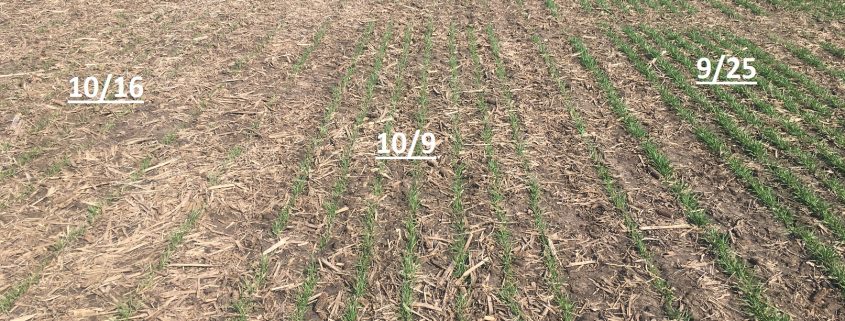Thoughts on Transitioning a Cover Crop into a Cash Grain Crop
My grandfather (whom I nicknamed Fudd), left school after the 8th grade due to farm obligations and may not have had the largest vocabulary nor could write in any legible form (we always teased him that he was a M.D.), but he could rattle off math and markets like no ones business. Today farmers are running their own calculations and right now, corn and soybean margins are TIGHT to say the least. A common question I have received over the last few days is how we can transition our cover crop acres into cash grain acres. Here a few thoughts to ponder:
- Is it legal?
- Determine if you have enrolled in any programs or cost-share that prohibit the sale of said crop.
- Check to see if there are any plant back restrictions due to previous herbicide or other pesticide use that limit the sale of said grain crop or livestock use of straw for feeding or bedding.
- Verify if the seed source has limits for sale due to PVP or genetic licenses.
- What cover crop specie(s) did you plant?
- Is this a cover crop mixture or a single species?
- A cover crop mixture will be difficult to manage for grain yield and straw yield and quality. We can only recommend considering transitioning your cover crop to a grain crop if it is a monoculture cover crop.
- Is it rye or wheat?
- Do I have a market for rye if I keep it for grain? See #1 above again.
- Do I have a market for the rye straw?
- What is your cost of production and required yield potential to actually make money? The common numbers I have floated are 90 bushels/acre of grain and 2 ton/acre of straw for wheat. For rye, the yield goals would be similar if not greater based on rye grain and straw price/value. Here are a few agronomic decisions that impact this threshold. These are suggestions generally for wheat. Rye we expect would be similar.
- Planting date matters: In WI, we start to lose yield after the last week in September at ~1 bu/acre/day.
- Here are a few scenarios to ponder:
- Scenario #1. Drilled cover crop on October 15th and seeding rate was increased accordingly. There is a good chance we will hit our yield mark. If the cover crop was drilled, but not planted in a standard narrow row spacing (7.5”), grain and straw yields may be lower and weed control may be more challenging.
- Scenario #2. Broadcast and lightly worked-in cover crop in mid-November. Poor chance we will hit our grain yield mark.
- Scenario #3. Flew on cover crop into established corn or soybean before leaf drop. If you have less than 12 plants per square foot…tear it up…. poor chance you will hit your grain yield mark.
- Scenario #4. Planted in August on prevent plant acres or following another small grain (oat or winter wheat). We don’t normally recommend a small grain followed by small grain but typically you can get by in year #2.
- Things to consider here: If you are selling for grain to an elevator watch out mixing grains. There is a good chance volunteers will come through and dockage can occur.
- Planting too early will put your crop at risk for Barley Yellow Dwarf Virus (BYDV). If the crop looks even and does not have irregular patterns across the field or in pockets you are likely good to go.
- For more information on establishment questions: Top 8 Recommendations for Winter Wheat Establishment in 2019
- Here are a few scenarios to ponder:
- Nitrogen timing matters. Get out there as soon as the ground is fit.
- Weed management matters. The value of this crop will be in both grain yield and straw yield and quality. Do not let the weeds get out of control. This is especially true if this was on prevent plant acres. Pay attention to herbicide labels for both crop growth stage and weed height restrictions. We don’t have many options for weed control in WI small grains. Here are a few tools to help in these decisions:
- Disease management matters for both grain and straw yield. Disease management is always a huge consideration in small grain production systems. This would even be more evident if this is a second year of small grain on small grain. We recommend scouting and watching the bottom line closely. The Feekes 5 timing that is often tied with a herbicide application is frankly a waste of money in WI unless significant early-season disease pressure is noted. We recommend scouting and estimating disease pressure at Feekes 9 (flag leaf) or Feekes 10.51 (anthesis or flowering). We have also measured an increase in straw yield (~0.5 tons of dry matter) with the Feekes 10.51 timing for fusarium head blight (FHB) or scab. Here are a few tools to help in these decisions:
- Planting date matters: In WI, we start to lose yield after the last week in September at ~1 bu/acre/day.
By the way my grandfather nicknamed me Finkle, after Mr. Weatherman Earl Finkle. His reasoning for this was that I was correct almost as often as he was…. LOL!!



